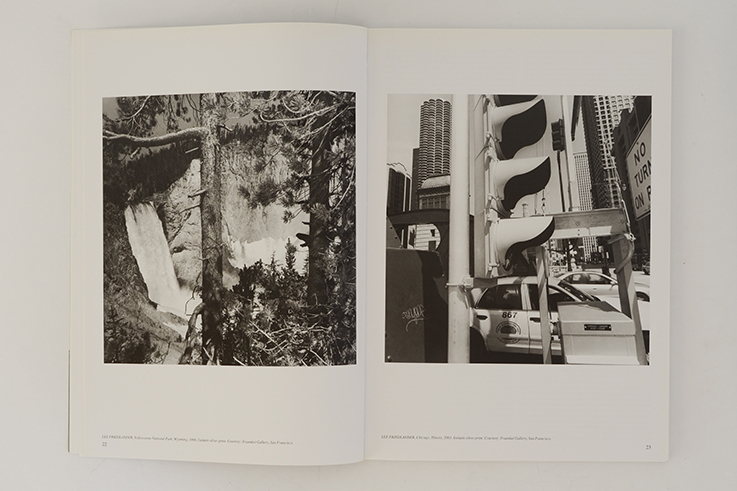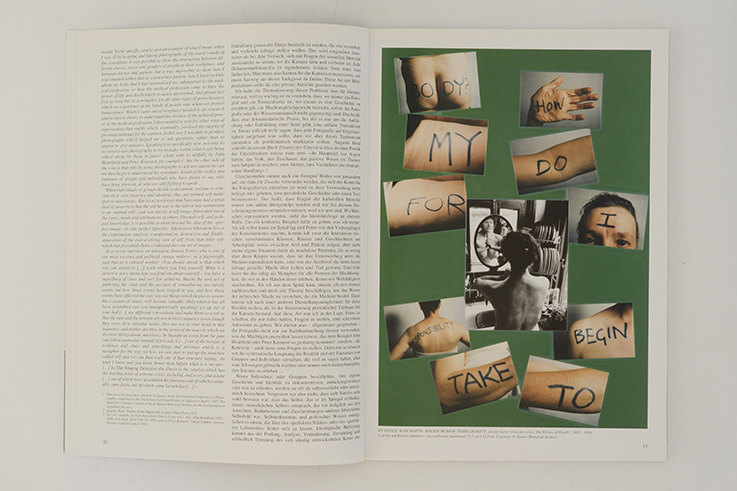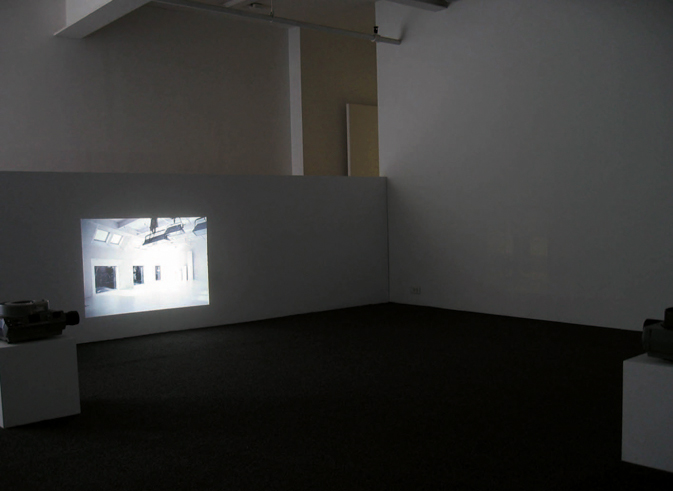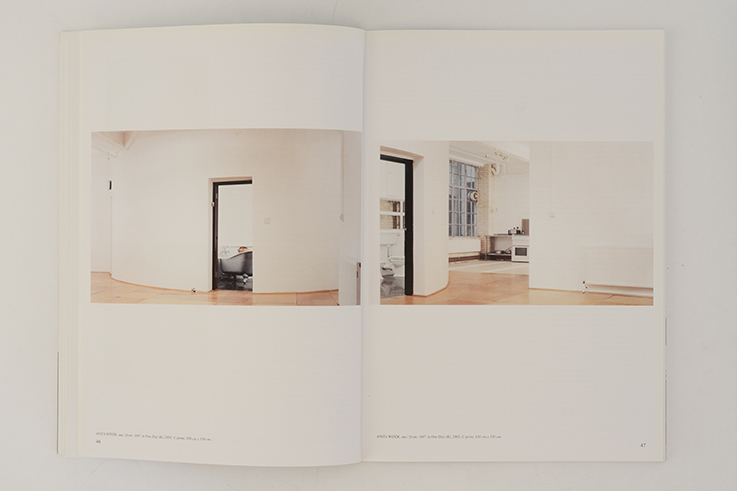Camera Austria International
94 | 2006
- MARK HAWORTH-BOOTH
Lee Friedlander - LEE FRIEDLANDER
- JO SPENCE
Questioning Documentary Practice? - JORGE RIBALTA
The Continuing Pertinence of Jo Spence - JO SPENCE
- BARBARA CLAUSEN
"becoming visible", a conversation with Anita Witek - ANITA WITEK
- BASAK SENOVA
Banu Cennetoğlu: Remotely Spying on Uncertainty.
- BANU CENNETOGLU
- RUTH SONDEREGGER
Critical Theory of Social Pictures II

Preface
In this issue of Camera Austria we are presenting Lee Friedlander and Jo Spence, two artist positions that have both had a major influence on the production and reception of photography. Lee Friedlander (who we had invited to an exhibit already in 1977 and who was a guest at our first “Symposium on Photography” in 1979) has had a profound impact on several generations of photographers due to the complexity, visual intelligence and irony of his pictorial work; his work is also very present in Europe at the moment thanks to the touring retrospective. Jo Spence, in turn, assumed a controversial position in the (also institutionally defined) photography debate of the 1970s and 80s, opting for what is at the same time a radically subjective and political approach. We presented her work for the first time in 1987 at an exhibition, subsequently publishing it several times in Camera Austria.Due to her early death in 1992, but also as a result of a lack of institutional commitment, her so publicly oriented work was the focus of hardly any reception for more than ten years. Thanks to a retrospective (on show at Camera Austria through the end of June 2006) organised by Jorge Ribalta from the Museum of Contemporary Art in Barcelona in collaboration with Terry Dennett, Jo Spence’s working partner and curator of the Jo Spence Memorial Archive, it is now possible to bring this important work back into the ongoing discussion with fresh impetus. We are also publishing the first German-language translation of a now historic speech held by Jo Spence in 1987, “Questioning Documentary Practice?”. This text will also be our first contribution to the documenta magazines project and will be available for critical reading on the public discussion platform.
Read more →Camera Austria International 94 | 2006
Preface
In this issue of Camera Austria we are presenting Lee Friedlander and Jo Spence, two artist positions that have both had a major influence on the production and reception of photography. Lee Friedlander (who we had invited to an exhibit already in 1977 and who was a guest at our first “Symposium on Photography” in 1979) has had a profound impact on several generations of photographers due to the complexity, visual intelligence and irony of his pictorial work; his work is also very present in Europe at the moment thanks to the touring retrospective. Jo Spence, in turn, assumed a controversial position in the (also institutionally defined) photography debate of the 1970s and 80s, opting for what is at the same time a radically subjective and political approach. We presented her work for the first time in 1987 at an exhibition, subsequently publishing it several times in Camera Austria.Due to her early death in 1992, but also as a result of a lack of institutional commitment, her so publicly oriented work was the focus of hardly any reception for more than ten years. Thanks to a retrospective (on show at Camera Austria through the end of June 2006) organised by Jorge Ribalta from the Museum of Contemporary Art in Barcelona in collaboration with Terry Dennett, Jo Spence’s working partner and curator of the Jo Spence Memorial Archive, it is now possible to bring this important work back into the ongoing discussion with fresh impetus. We are also publishing the first German-language translation of a now historic speech held by Jo Spence in 1987, “Questioning Documentary Practice?”. This text will also be our first contribution to the documenta magazines project and will be available for critical reading on the public discussion platform.
A contribution by Basak Senova continues a co-operation that provides insights into the current Turkish art scene: here the author focuses on the concept artist Banu Cennetoglu, whose documentary photography projects on different areas (including a military zone, a rest home, etc.) led to the theory of “The Emptying of Space”, that (on the surface) contrasts sharply with the respective socially and politically defined functions of these spaces. In contrast, in an interview with Austrian artist Anita Witek, Barbara Clausen ascertains that, in her form of media-reflective and media-critical re-contextualisation of photographic material, the artist establishes new narrative structures, that draw our attention to constructions and varieties of media reality. With displays that she is constantly developing anew she subversively undermines the mediatic constructions of reality, opening a political discussion on the ways in which we perceive social spaces and the contexts of negotiation that become visible in them.
This year again we are featuring with Camera Austria at numerous art shows; this year, however, we will not have access to such important markets as the frieze Art Fair in London and Art Basel. A thriving magazine market is apparently creating a necessity for new forms of selection, while continuity of appearance and consistency of content seem to be irrelevant. We must accept the fact that a project such as Camera Austria, that has developed its profile not only through close co-operation with international artists, but that also undoubtedly continuously and firmly represents the critical (and political) discourse in the form of media-critical and media-reflective work, is to have no place at the big art fairs any more. We think that this kind of de-politicisation is a questionable development: this not only almost completely subjects a social niche, that has so far been available for the development and dissemination of critical discourses, to the logic of the market, but equally creates a chasm between institutions and events on the markets.
Christine Frisinghelli
Entries
Forum
VERENA WINKELMANN
MINZHU CAO
JOYCE ROHRMOSER
KLAUS MÄHRING
CHARLOTTE LYBEER
GERHARD KOWALD
SALVATORE ARANCIO
PAUL DIVJAK
Exhibitions
Joachim Koester. Morning of the Magicians and Other Works
Galleri Nicolai Wallner, Copenhagen
NIELS HENRIKSEN
The 4th Berlin Biennial for Contemporary Art: Of Mice and Men
KW Institute for Contemporary Art, occupying a variety of locations along Auguststraße in Berlin Mitte
DENISE ROBINSON
Frank Thiel. Void Territory
Sean Kelly Gallery, New York
CARLO MCCORMICK
Prekinjene Zgodovine. Interrupted Histories. Arteast Exhibition
Moderna galerija / Museum of Modern Art, Ljubljana
SANDRA KRIŽIĆ ROBAN
Kontakt… Aus der Sammlung der Erste Bank-Gruppe
MUMOK, Wien
HILDEGUND AMANSHAUSER
While Interwoven Echoes Drip into a Hybrid Body – An Exhibition about Sound, Performance and Sculpture
Migros Museum, Zürich
HANS-JÜRGEN HAFNER
De-Regulation with the work of Kutlug Ataman
MuHKA, Antwerpen; Herzliya Museum, Tel Aviv; KW Institute for Contemporary Art, Berlin
ANNETT BUSCH
Die Unsichtbaren Filme. 40JAHREVIDEOKUNST.DE – Teil 1 digitales Erbe: Videokunst in Deutschland von 1963 bis Heute
Kunsthalle Bremen; K21 Kunstsammlung Nordrhein-Westfalen, Düsseldorf; Städtische Galerie im Lenbachhaus München; Museum der bildenden Künste Leipzig; ZKM Karlsruhe
HIAS WRBA
Kino wie noch nie / Cinema like never before
Generali Foundation, Wien
RAINER BELLENBAUM
Schauinsland. Gute Aussichten. Junge deutsche Fotografie 2005/2006
Ausstellungsstationen in Berlin, Hamburg, Dortmund, Frankfurt, München, sowie den Goethe-Institutionen in Marokko, den USA und Algerien
KERSTIN STREMMEL
Heidi Specker. Im Garten.
Sprengel Museum, Hannover
Sammlung Ann und Jürgen Wilde Bangkok. Heidi Specker Germaine Krull
Sprengel Museum, Hannover
CAROLIN FÖRSTER
Die Wirklichkeit durcharbeiten. Manfred Willmann. Werkblick
Neue Galerie am Landesmuseum Joanneum, Graz
Manfred Willman. Das Land
PhotoEspaña2006, Círculo de Bellas Artes, Madrid
REINHARD BRAUN
Ken Ohara. Erweiterte Portraitstudien
Museum Folkwang, Essen; Städtische Galerie Wolfsburg; Fotomuseum im Münchner Stadtmuseum
WOLFGANG BRÜCKLE
Fotohof 1981 – 2006
Fotohof, Salzburg
MANISHA JOTHADY
Sharon Lockhart. Pine Flat Portrait Studio
neugerriemschneider, Berlin
KRYSTIAN WOZNICKI
Jeanne Faust. Outlandos
Galerie Guenther/Borgmann, Hamburg
JENS ASTHOFF
Books
Katharina Menzel-Ahr: Lee Miller. Kriegskorrespondentin für Vogue. Fotografien aus Deutschland 1945
Jonas Verlag, Marburg 2005
MARGARETHE SZELESS
La Ville au Cinéma. Eine Französische Enzyklopädie sammelt Wissen über die Wechselwirkungen von “Stadt und Kino”
Cahiers du cinéma, Paris 2005
GISLIND NABAKOWSKI
Ulrike Ottinger: Bildarchive. Fotografien 1970 – 2005
Verlag für moderne Kunst, Nürnberg 2005
MAREN LÜBBKE-TIDOW
La Panaderia. 1994 – 2002
Editorial Turner de México, 2005
KRYSTIAN WOZNICKI
Helmut & Johanna Kandl: Business or Pleasure. Photos & Stories
Fotohof edition, Salzburg 2005
ANDREA DOMESLE
Imprint
Publisher: Manfred Willmann. Owner: Verein CAMERA AUSTRIA, Labor für Fotografie und Theorie
All: Lendkai 1, A-8020 Graz
Editors Graz: Reinhard Braun, Christine Frisinghelli, Tanja Gassler
Editor Berlin: Maren Lübbke-Tidow
Copy editing: Marie Röbl
Translations: Wilfried Prantner, Richard Watts, Marina Miladinov, Josephine Watson, Aileen Derieg















